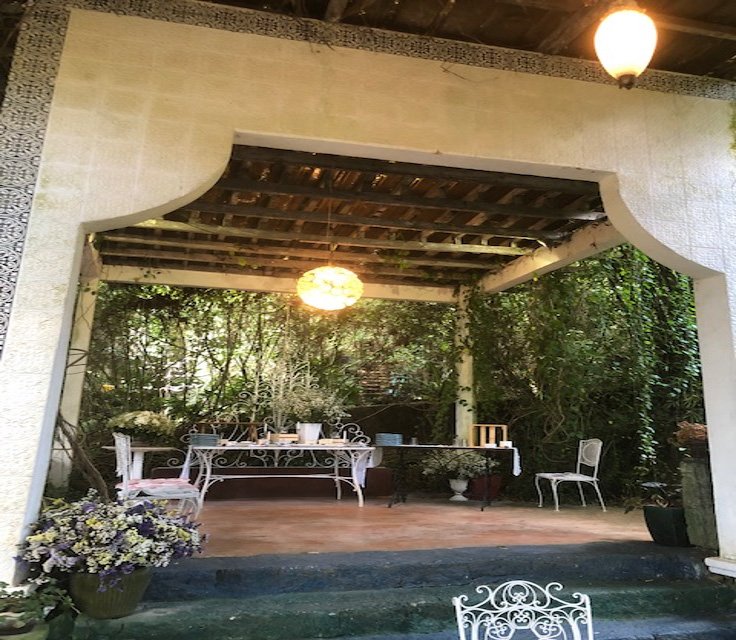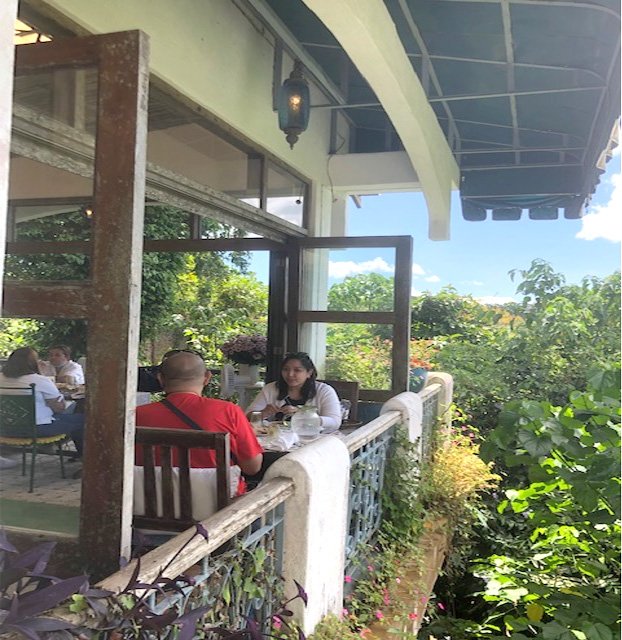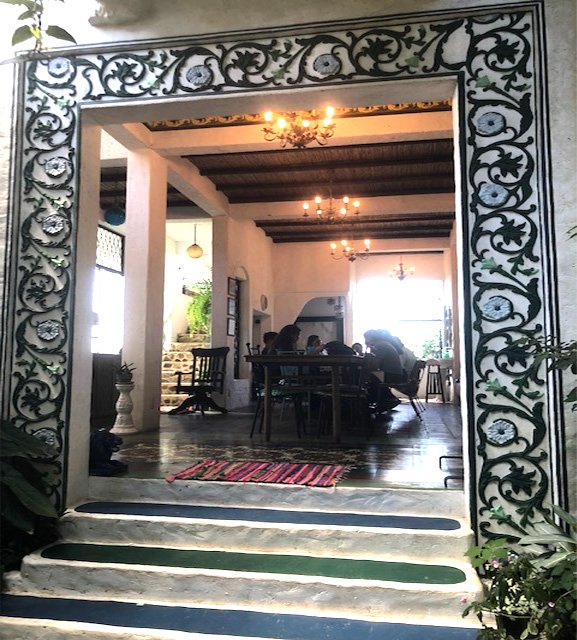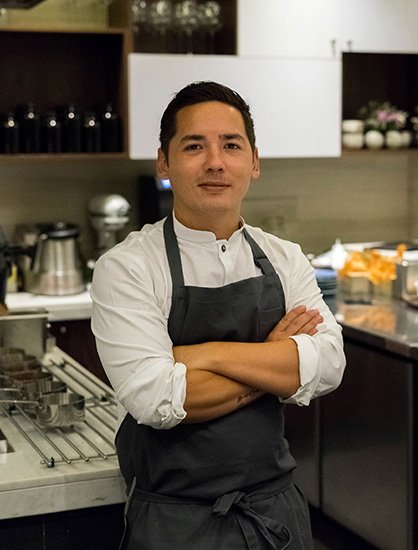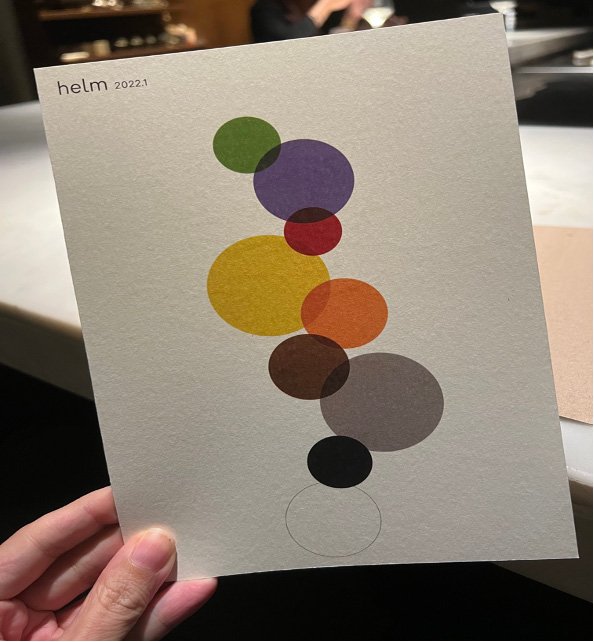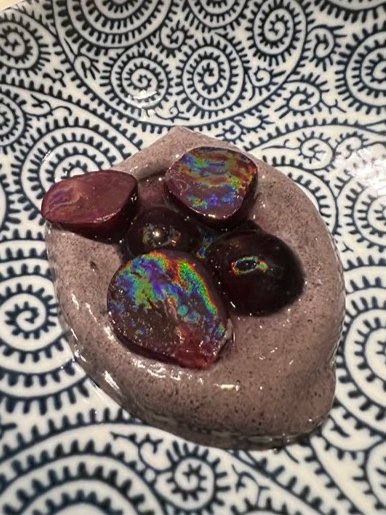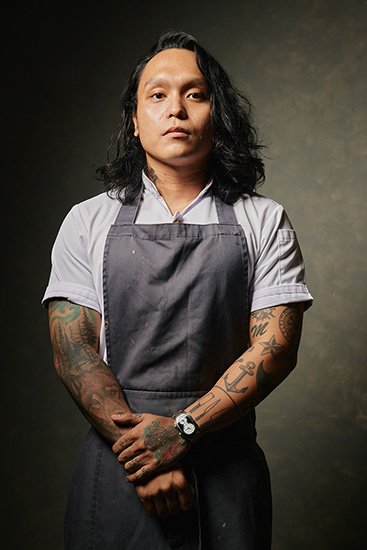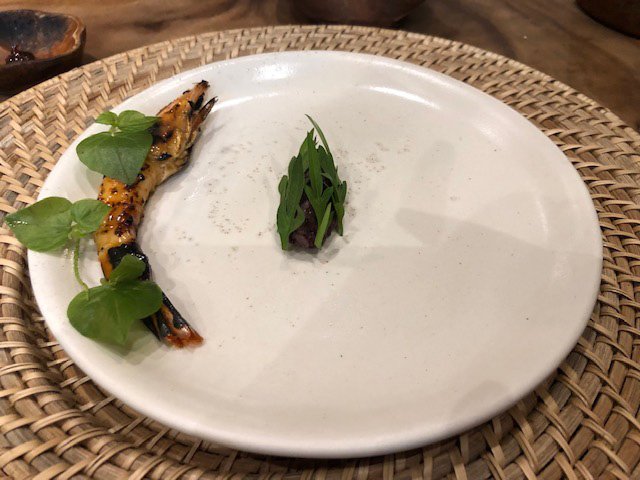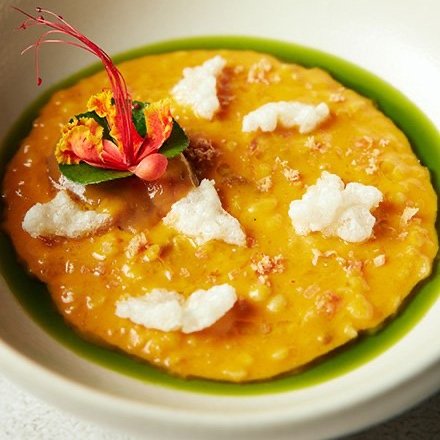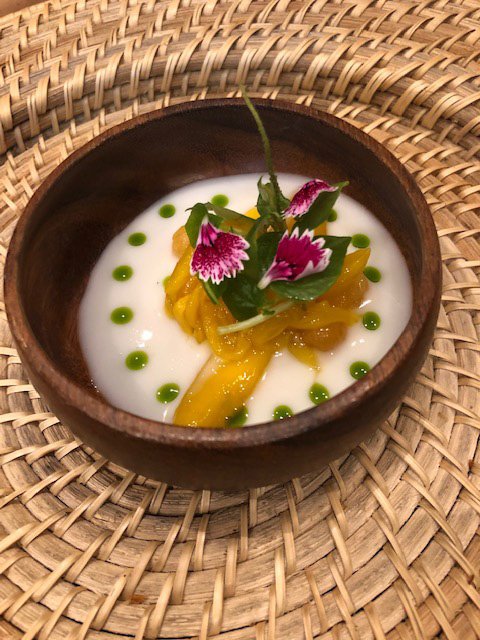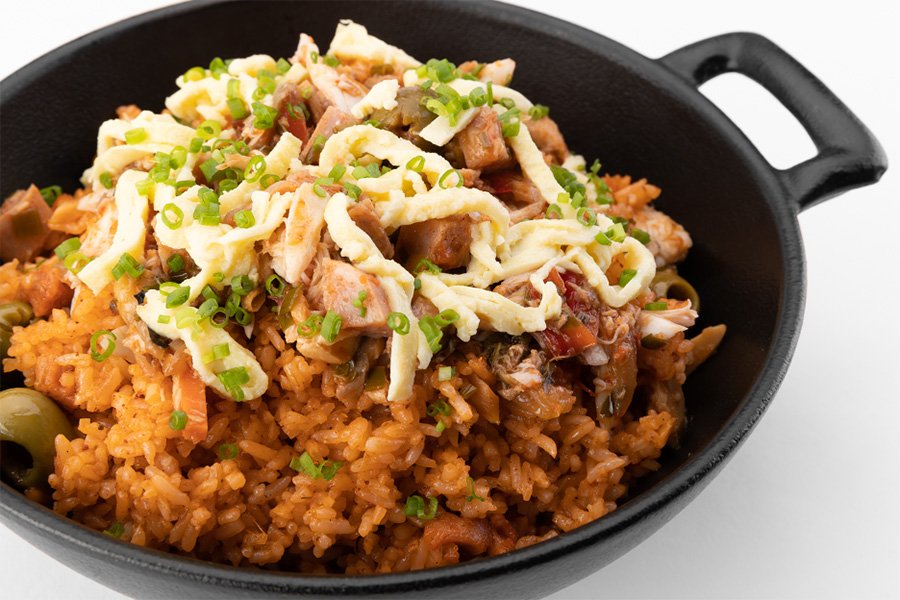Food-Tripping in Manila (and Nearby)
/There will always be a new restaurant to try in Manila, and that is why, after a trip there, I need to lose unwanted pounds. All meetings and social occasions center around food, not just for an hour or so; they could last the whole day. There is a restaurant, carinderia or fast food outlet on almost every street corner, several in one block alone. How can you not resist? The dining scene is exploding with new restaurants mostly in the Mall of Asia area and in Bonifacio Global City, with young, daring, and creative chefs eager to showcase their talent. Here are a few I was lucky to taste.
Marcia Adams
JP Rizal Street, Barangay Sikat, Alfonso, Cavite. Tel. : 0917-801-1456.
One of the outdoor dining areas. (Photo by Mona Lisa Yuchengco)
My favorite restaurant in Tagaytay, Antonio’s, was full and they wouldn’t let us in without a reservation. “Let’s go to Marcia’s instead,” my friend said. “It’s just up the road, and I like the food there too.” After about ten minutes, we arrived at our destination. From the outside, it looked like a regular house, but as you walk inside, descending stony pathways and lush foliage greet you. Several dining areas are scattered around the garden property, each one resembling a slice of Mediterranean culture through the arches and huge open windows, chandeliers, wrought-iron and antique wooden chairs and tables mostly bought from second-hand stores, plus crocheted placemats and runners for a Filipino touch. What started as an Italian farmhouse expanded to include a Spanish Sunset Lounge, a Greek Terrace, and a Provencale Pavilion.
Large open windows give an airy, fresh and calming atmosphere. (Photo by Mona Lisa Yuchengco)
The menu includes Mediterranean favorites like hummus, Aegean salad, kebabs, casseroles, ratatouille, fish souvlaki, and pastas.
The owner and chef of Marcia Adams is Marcia Ciupan from Antique who is married to a retired British engineer, Neil Adams. They met at a McDonald’s in Manila while Neil was working on a waste conversion energy project. The couple moved to Cavite with their four children and bought a two-hectare farm where they grew vegetables and fruits and built a restaurant.
“The porkchops are the best,“ my friend swears. I tried the truffled steak and it was delicious! It’s worth a drive; just be prepared for the traffic to and from Tagaytay, especially on weekends.
The decorative entrance to another dining area. (Photo by Mona Lisa Yuchengco)
Helm
The Plaza of Arya Residences, McKinley Parkway, Bonifacio Global City. Tel.: 0917-304-1570, P5,000+/person
Chef Josh Boutwood is one busy person. In addition to the three restaurants he personally manages and cooks for -- Helm, The Test Kitchen, and Savage -- he is also the executive chef of The Bistro Group where he manages 130 restaurants in the Philippines. The Bistro Group owns famous restaurants like Italianni’s, Bulgogi Brothers, Buffalo Wild Wings, Denny’s, etc. Boutwood was named one of the Young Talents of the Year by international restaurant guide, La Liste, in 2021.
Chef Josh Boutwood of Helm (Source: Esquire PH)
The 34-year-old Filipino-British chef (Filipino father and British mother) grew up in England and Spain at his parents’ restaurants, at first cleaning the bar, sweeping the floor or washing apples. Upon the suggestion of his mother, he enrolled in culinary school but discovered he didn’t enjoy the culinary theories as much as actual cooking time in a kitchen. He left school and never looked back. A stint at the prestigious Le Manoir aux Quat Saisons in Oxford, England left him disappointed and homesick.
In 2007, while visiting his father, Boutwood met his future wife, Nilla Strom, a Swedish national, in Boracay where his father ran the Fridays beach resort. The couple and their first child moved to the island in 2010, and he opened his first restaurant, Alchemy. When Boracay became a party island, the Boutwoods knew it was time to move on to better things, and coincidentally, The Bistro Group called and offered him a job. The company also offered him the opportunity to partner and open his own restaurants.
The ten-seater Helm (guests sit around a curved bar) “offers serious gastronomes an unmissable chance to watch one of Asia’s most exciting young chefs create culinary magic,” writes theworlds50best.com. Helm was in the World’s 50 Best Restaurants’ Discovery Series in 2021.
The evening we were there, Boutwood served a monochromatic meal where each dish had a dominant color in varying hues.
The monochromatic menu. (Photo by Sunshine Puey)
Appetizers included: Fish and Chips – hamachi and horseradish, trout and sea buckthorn (left), Black Pepper French Toast – hickory smoked mussels, lemon and dill (center), and Oxtail Rillet – raisin port and sunflower shoot (right). (Photo by Sunshine Puey)
Green – Japanese cucumbers compressed in roasted sesame oil, raw tuna, avocado, tapioca, green mango and nasturtium. (Photo by Sunshine Puey)
Purple- porridge of Adlai cooked in ube, local octopus lightly poached and grilled, puffed Adlai and dehydrated red cabbage. (Photo by Sunshine Puey)
Red- tartare of yearling lamb, garlic and beetroot. Yellowtail cured in Szechuan pepper, garlic and beetroot. (Photo by Sunshine Puey)
Yellow- pumpkin and sunflower seeds roasted in hay, 67*C egg yolk, espuma of potato infused with saffron oil topped with brioche and preserved egg yolk. (Photo by Sunshine Puey)
Orange- coho salmon, curry leaf, roasted carrot and crab fat and tomato (oil and powder). (Photo by Sunshine Puey)
Brown- foie gras and mushrooms. Sweet potato leaf and local cacao and black pepper cracker. Sauce: black fungus mushroom and preserved gooseberries. (Photo by Sunshine Puey)
Grey- short rib of beef cooked for 72 hours, paste of shiitake, button and chestnuts cooked in bone marrow. Burnt eggplant purée and black garlic emulsion. Squid ink and bone marrow gravy. (Photo by Sunshine Puey)
Black- strawberry and charcoal sorbet, sour strawberry sauce and black grapes compressed in lemongrass oil. (Photo by Sunshine Puey)
White- coconut and lime ice cream, Nata de coco marinated in lime leaf syrup, dried macapuno, Coconut milk and vanilla foam and egg whites. (Photo by Sunshine Puey)
Chef Boutwood has a pleasing personality as well. He describes the dishes with a British accent and cajoles his guests. It was truly an entertaining and delicious dining experience.
Hapag
201 Katipunan Road, Project 4, Quezon City. Tel.: 0916-781-4141, P3,800/person.
Hapag (Photo courtesy of Hapag MNL)
Chef Kevin Navoa or Chef Nav as he is fondly called, says his mother influenced his culinary career. “She didn’t cook anything crazy, but it was just honest-to-goodness home-cooked food. Being a young boy, having a mum that was fond of cooking was great because you looked forward to dinners coming home from school,” he said in an interview with Tatler magazine.
The restaurant is part of Asia’s 50 Best Restaurants’ Essence of Asia collection. At Hapag, Filipino cuisine is elevated in a modern, elegant fashion, with the use of regional produce to support farmers and artisans, like coffee oil from Benguet, fine cacao from Mindanao, and locally bred goat meat.
What stated in 2017 as Hapag Private Dining, where guests dined at home, grew into a commissary, to keep up with the demand, and a restaurant. Then COVID hit, but the chefs used this period to hone their skills and craft and plan more on the things they were lacking.
At Hapag, Navoa is joined by chefs Thurdy Dolatre and Kevin Villarica and the couple Ricky and Bubu Andres. Dolatre worked at 3-Michelin Star Benu in San Francisco, Navoa was employed at Dewakan Restaurant in Kuala Lumpur, Malaysia, and Villarica was a chef for the in-flight catering company of Singapore Airlines. Ricky and Bubu Andres started Candy Corner several years back. The four partners combined their culinary experiences to produce something new and interesting in this 25-seater restaurant -- degustation, Filipino style. “We think of our food as something that pushes the boundaries of Filipino cuisine yet gives you a sense of nostalgia,” says Dolatre.
Chef Kevin Navoa (Photo courtesy of Hapag MNL)
Chef Thurdy Dolatre (Photo courtesy of Hapag MNL)
Chef Kevin Villarica (Photo courtesy of Hapag MNL)
Hapag’s ten-course tasting meal changes seasonally. Here are some dishes in the tasting menu.
Pan de Kalinga is Hapag’s fermented black rice sourdough, butter with Palawan honey, fermented with bubod sweet potato halaya with Malagos cheese. (Photo courtesy of Hapag MNL)
Snack Box: (left to right) Chicken Inasal Cracker made from Chicken Tuille, Chicken Inasal Parfait and seasonal fermented jams; Champorado at tuyo made from Black sticky rice with Auro Dark Chocolate and seasoned with patis then turned into a rectangular croquettes topped with Crispy Palad and latik; Keso at Kabute Tartlet -- Confit local Oyster mushroom, Kesong puti mousse with smoked leeks; Empanada with pork longganisa, papaya, homemade banana ketchup, and sukang iloko emulsion; Kadyos Caramel Kutsinta made from fermented kadyos with Koji (which is also called Kadyos Shoyu) for 6 months and turned into caramel and made to resemble kutsinta. (Photo courtesy of Hapag MNL)
LuzViMinda: (back) For Luzon, Kilawing Baka - a small bite similar to beef tartare using local tenderloin from Batangas, tossed in fermented mustard, topped with pickled Gamet which is a local seaweed for Ilocos, and a patis-cured egg yolk puree; (left) For Visayas, Scallop Napoleones - sandwiched between our homemade puff pastry is a refreshing grilled eggplant ensalada and brunoise of Iloilo scallops tossed in house-fermented miso; (right) For Mindanao, Crab Alavar Chip - Alavar is a Chavacano dish from Zamboanga made out of crab simmered in coconut milk and taba ng talangka (crabfat), topped with pineapple-palapa jam, fresh Davao pomelo, and served on a crispy Lato cracker. (Photo by Mona Lisa Yuchengco)
Inihaw na sugpo sa miso. (The glaze on the prawn is made from 11-month old Rose Munggo Miso, burong kanin (fermented rice) with green mangoes and served with picked papaya and herbs. (Photo by Mona Lisa Yuchengco)
Uni arroz caldo. Topped with puffed rice, cured bihod bottarga and spring onion oil. (Photo courtesy of Hapag MNL)
Kinaskas – shaved ice made from Benguet strawberries dipped in yogurt and calamansi sago. (Photo by Mona Lisa Yuchengco)
Salu Salo – Inihaw na baboy grilled with Kanto sauce, pinasingaw na lapu-lapu steamed with black bean miso paste, binusog na manok stiffed with chicken and mushroom embutido with lemongrass sambal. Sides include ensaladang manga, burong mustasa, inihaw na pako and pandan rice. (Photo by Mona Lisa Yuchengco)
Tropical fruit salad, dairy free and vegan friendly. Cream is cooked with cooked rice and koji. (Photo by Mona Lisa Yuchengco)
Chocnut topped with honeycomb and shards of chocolate barquillos (Photo courtesy of Hapag MNL)
Buko tart with coconut pastry cream and calamansi topped with queso de bola crisps. (Photo by Mona Lisa Yuchengco)
The evening was not only a culinary adventure, but also a learning experience (learning about new ingredients from the different provinces) and a proud moment that young talents are willing to push the envelope on Filipino food and create new, exciting, and flavorful tastes. Definitely worth a second try.
Haliya
Asean Avenue, Nuwa Hotel City of Dreams Manila, Tambo, Paranaque, Metro Manila. Tel.: (632) 8691-7780
Named after the eponymous beautiful warrior goddess of Bikolano mythology, Haliya is helmed by Chef de Cuisine Edmundo San Jose whose 24-year culinary experience includes restaurant operations in the Philippines and the Middle East. He has won cooking competitions at the Horeca Kuwait Culinary Show from 2013 to 2015, and in 2016 he led a Dream Team to win the gold medal in the Philippine Culinary Cup.
Chef Edmundo San Jose (Photo courtesy of City of Dreams)
Everything in Haliya screams modern – from the location and dining room décor to the paintings by Yana Ofrasio and the menu. City of Dreams is a luxury casino resort in Paranaque, part of the Aseana City development that includes the latest in entertainment, retail, dining, and gaming facilities.
Haliya’s dining room (Photo courtesy of City of Dreams)
“I take inspiration from staple Filipino homecooked meals, with an intent to enhance the basic flavors that we all love and grow up with. In combining the traditional way of cooking Filipino dishes with the creative techniques I’ve learned in my two decades of exposure to Asian and international cuisine, I am delighted to offer new interpretations of Filipino classical dishes in Haliya that will appeal to local and international palate,” says Chef Ed.
Haliya’s Adobo features twice-cooked chicken, foie gras, grilled pineapple, shallot confit, baby bokchoy, marble potatoes, set in lush adobo glaze and enhanced with golden crispy garlic chips. (Photo courtesy of City of Dreams)
Haliya’s Binalot na Cochi, a medley of shredded cochinillo (roast sucking pig) and adobo flakes in a bed of butter lettuce topped with atsara (pickled green papaya), red onion and pork liver salsa. (Photo courtesy of City of Dreams)
Haliya’s Tinapa (smoked fish) rice with aligue (crab fat) and tinapa salsa. (Photo courtesy of City of Dreams)
Haliya’s Chichingka (bibingka cheesecake) served on the table in a burner pot. (Photo courtesy of City of Dreams)
In addition to those dishes featured above, Haliya’s menu includes other Filipino favorites like kilawing tanigue, kare-kare, paksiw apahap, bistek Tagalog, binakol rice and other desserts like leche flan, taho and mangga suman.
There are numerous Chinese restaurants in the Mall of Asia area that are good, namely, China Blue at the Conrad Hotel, Crystal Dragon at the City of Dreams, and East Ocean where every party, regardless of number, has their own private room, complete with personal waiter and toilet.
All these restaurants are well worth a visit. Just try not to over-eat like I did.


